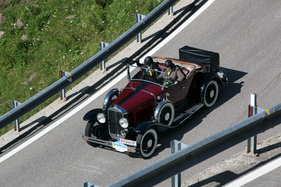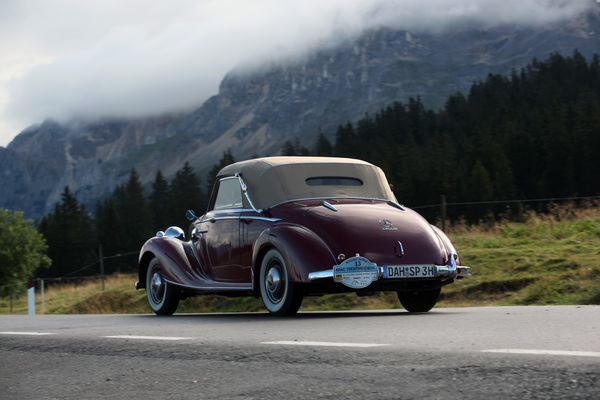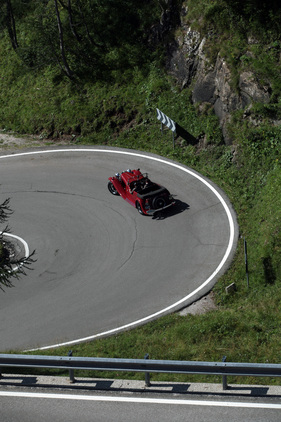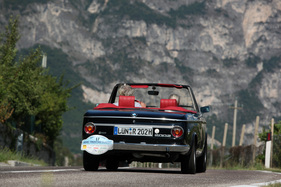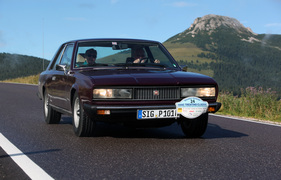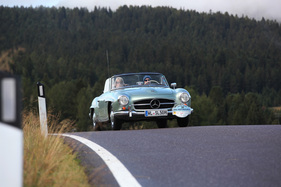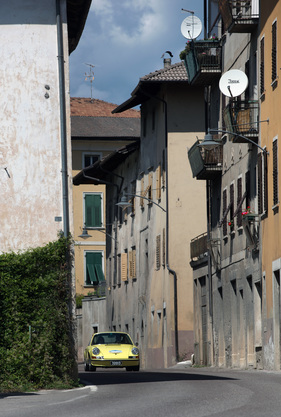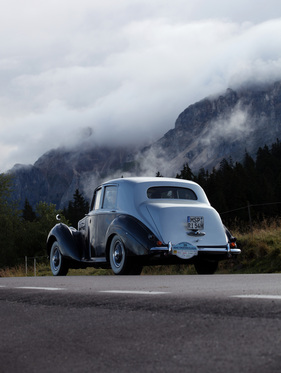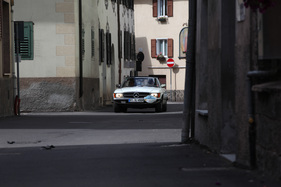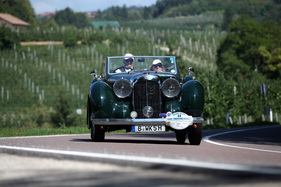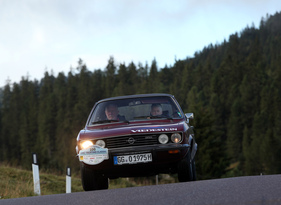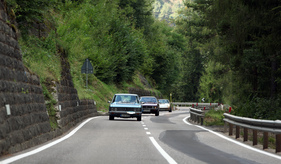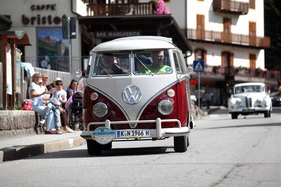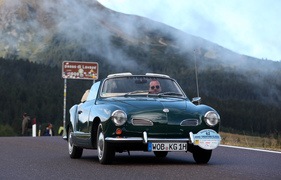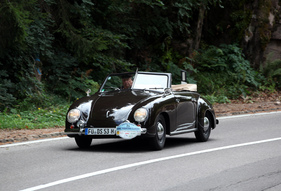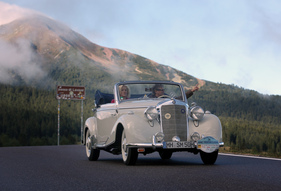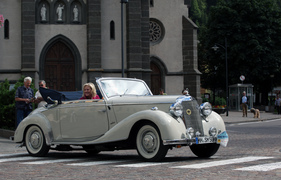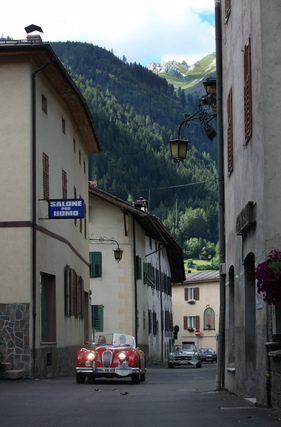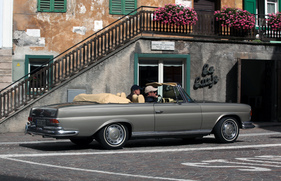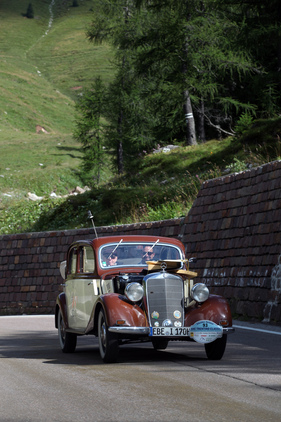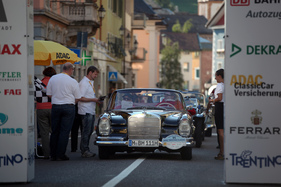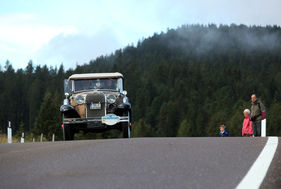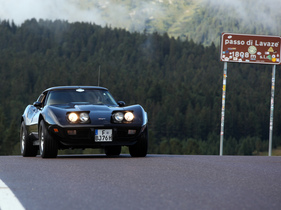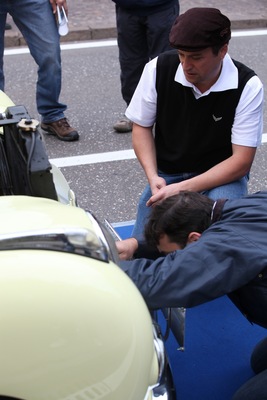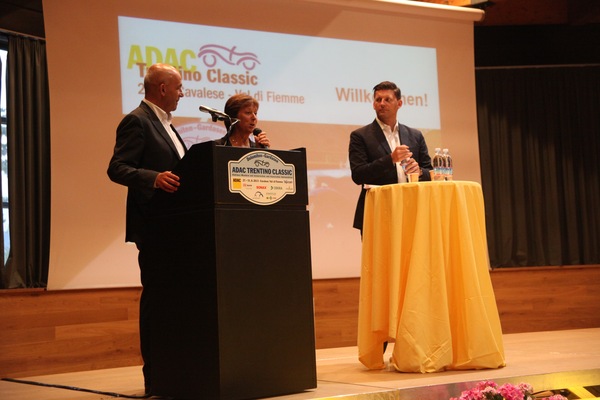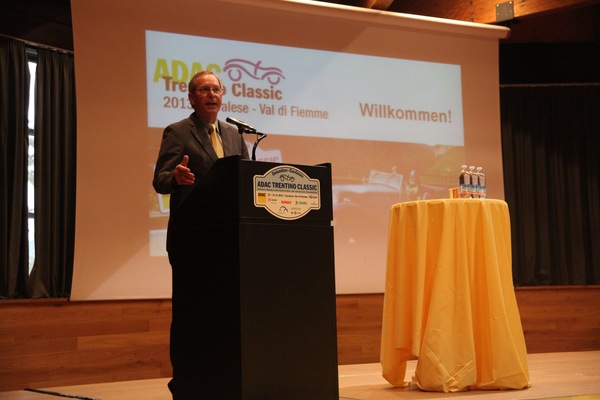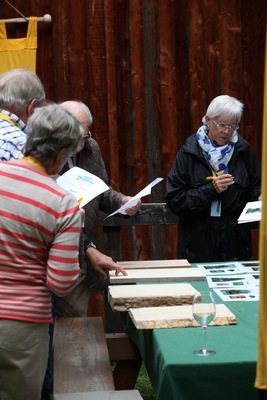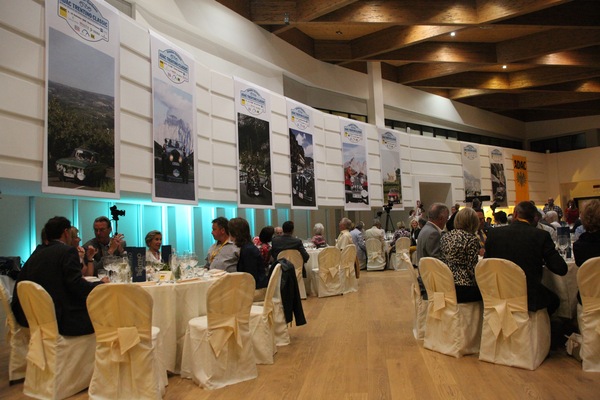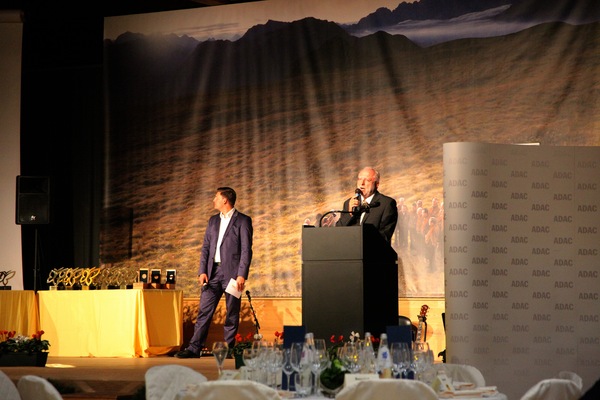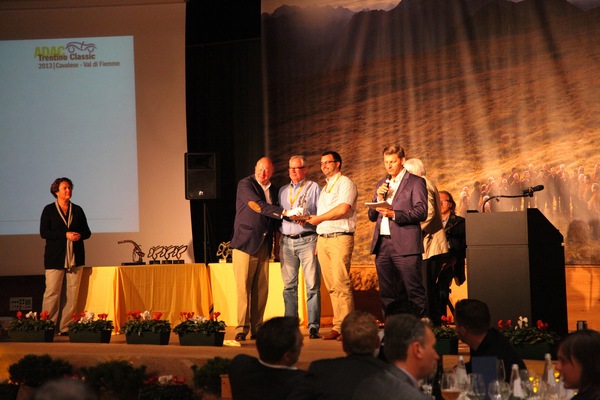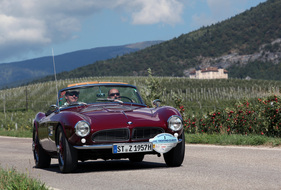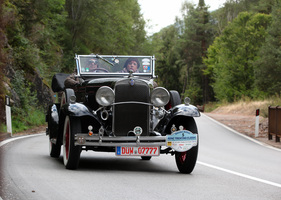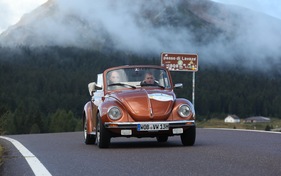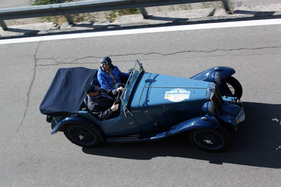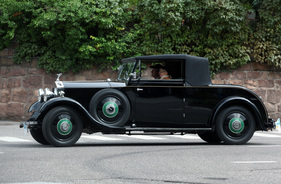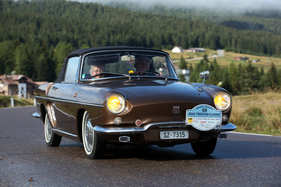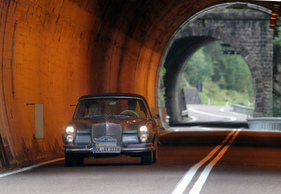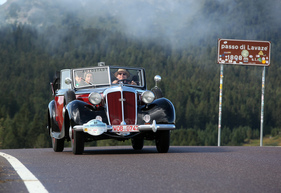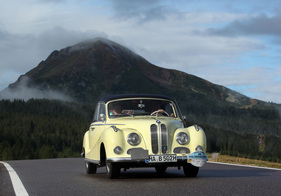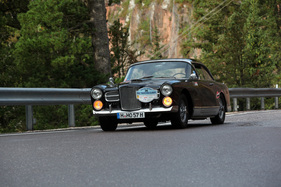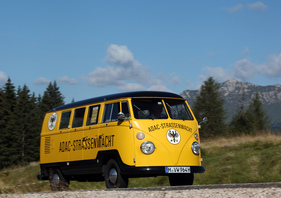Mario Theissen, who has been the ADAC's classic car consultant for several months, said in his speech at the drivers' briefing: "I have never taken part in the Mille Miglia with my wife, but here at the Trentino Classic she is sitting next to me in the car". He was referring to the typical characteristic of "classic car touring", i.e. not causing stress in the cockpit or in the engine compartment.
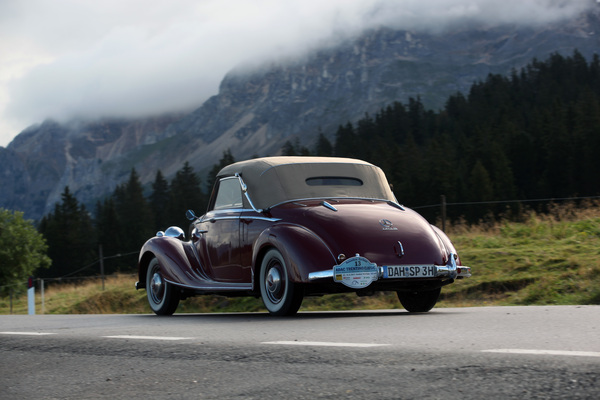
The pleasure element of classic car touring
The term "classic car hike" is no coincidence for this popular ADAC event. Just like a mountain hiker, participants in the Trentino Classic follow a predefined circular route. Instead of hiking signposts, there are small pictograms on the route that indicate the next change of direction (triangle means straight ahead, circle means turn right, square means turn left).

Instead of special stages, there are walking breaks (WP), where a snack is usually offered and a task to be solved is set. This year, for example, participants had to identify types of wood, estimate the weight of a piece of cheese they had cut themselves or move a golf ball between two light barriers in exactly two seconds. These were the only light barriers during the entire event, as there is no timekeeping, hose tests or similar tests of skill for the vehicles during the classic car hike. Only the brain is required and, of course, attention, as the small pictograms on the road must be recognized in good time so as not to lose the way.
The vehicles start according to set times, but this is not taken meticulously seriously. You can start (and arrive) a little earlier or later as long as you stay within the given time frame.
There are also tips in between, such as a visit to Alois Lageder's winery or the Museum Geologico delle Dolomiti, to name just two examples.
Organizational mammoth task
No timekeeping, no special stages, a few questionnaires and exercises - anyone who thinks that the organizational effort is therefore minimal is mistaken. The ADAC people left nothing to chance, for example driving the routes again beforehand to ensure that the signposting was still in place and correct.
The fact that the signs were nevertheless removed twice on the last tour (by a prankster?) could hardly be prevented. A lot of staff were also deployed at the meeting points for the hiking breaks, and as several of these points had to be set up, manned and dismantled at the same time, many helpers were needed. In fact, more than 40 people from the ADAC were needed to ensure that everything ran smoothly.
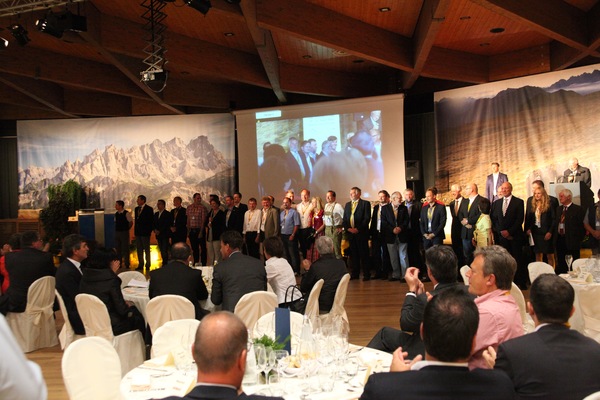
For 10 years
The first Trentino Classic was launched in 2003 to mark the 100th anniversary of the ADAC. The classic car hike in Trentino became the flagship of the ADAC Classic events and was much sought after. The ADAC can count itself lucky that up to four requests are received for each starting place.
In fact, some participants were able to say that they had already tried to register several times without success, but only succeeded this year. One Swiss participant suggested that it was probably due to the vehicle, that it was better to come with a rare car and that the Renault Floride was a good fit.
Every year, the Trentino Classic chooses a different region to stage four tours. The starting point is a different town each year, but it remains the location and starting point for the entire event.
Unknown Trentino
Often seen as part of South Tyrol, Trentino is in fact an autonomous province in its own right which, together with South Tyrol, forms the "Trentino-Alto Adige" region. As an autonomous province, Trentino can use 90% of its taxes itself and in return has to organize public tasks such as road construction or schools itself.
With over 6,000 square kilometers and 530,000 inhabitants, Trentino, which lies between South Tyrol, Veneto and Lombardy, is an important region that is also home to the "Ladin", "Fersental" and "Cimbrian" language minorities.
Cavalese, the location of this year's Trentino Classic, is situated in the Val di Fiemme (Flammental) in the north-east of Trentino and was also the venue for the Nordic World Ski Championships in 2013. At around 1000 meters above sea level, Cavalese is home to around 4,500 inhabitants and is naturally heavily geared towards tourism, as is the entire region. The winter and summer visitors come from Italy, of course, but the Czech Republic, Poland and Germany follow.
Not just for coffee connoisseurs
In contrast to South Tyrol, Italian is spoken almost exclusively in Trentino. And you immediately feel that you are in Italy. No matter how small a place, bar or café may be, it will serve a great espresso or cappuccino and the paninis are first class.
In general, there is a lot on offer in culinary terms, and the participants of the Trentino Classic were able to see this for themselves during the breaks between hikes, but also at the organized evening events. Even a star chef was on hand to serve elaborately staged pasta on the gala evening.
Four tours of different lengths
At the center of this year's Classic were four tours of different lengths. In the (Dekra) prologue, a 65 km round trip to the south was completed, while the second day of riding took the participants to the north and over the Lavazé and Sella passes (Sonax Cup).
In general, most of the routes were constantly up and down, with long straight stretches of road being the exception. In many cases, side roads were used on which it could get really narrow, at least for the wider vehicles.
The third 190 km round trip (Autostadt-Pokal) took around 100 vehicles over the Passo Rolle to San Martino di Castrozza, where the Concours d'Elégance took place.

All vehicles were examined in detail by the jury, which consisted of Mr. Weitekamp (ADAC), Mr. Bockelmann (Volkswagen), Mr. Ruthman (Dekra), Mr. Kleber (ADAC) and Mr. Thoma (ADAC), and judged in three classes (up to 1945, 1945-1960, 1961-1983). The winner in Class III was the Porsche 911 2.2 S Coupé from 1971 driven by Jules Tibolt and Sylvie Walisch; in Class II, Dr. Karlhein and Christl Lange took the trophy for their BMW 507 Touring Sport from 1957; in Class I (pre-war), the Auto Union DKW Front luxury two-seater from 1935 driven by Reinhard and Rosemarie Pfau came out on top.
The last round trip over 150 km (Autozug-Pokal) took the participants to the west. Passing Lake Kaltern, the route went over the impressive Mendel Pass to Castel Thun.
In any case, all participants got plenty of driving in. Pass crossings and picturesque village crossings alternated with hairpin bends and valley crossings. And the weather mostly played along, as most of the routes could be tackled with an open roof (if available).
The pre-war group also got around well and, unlike some rallies, didn't have to complain about hardly getting a chance to eat or sleep.
Exceptional cars at the start
But it wasn't just the Concours winners that were exceptional vehicles; there were many rarities and gems to discover in the field of around 100 cars. For example, there was an Intermeccanica Indra, a Bitter CD and two four-door convertibles from BMW and Mercedes Benz.
The former was one of the few Baur Cabriolets produced, based on the BMW 502 A from 1955, while the latter was a Mercedes Benz 300d Cabriolet from the W 189 series from 1959.
And the fact that there were also less commonplace alternatives to the Mercedes Benz brand, which was represented by over 30 vehicles, was ensured by an S.S. One, an MG L-Type Magna, a Borgward Isabelle Coupé, a Facel-Vega, a Lagonda V12 DHC, a Maserati 3500 GT, a Citroën DS21 i.e. or a Renault Floride, to name just a few examples.
"Yellow angels" constantly on duty
At the driver briefing, the "yellow angel" Sigi pointed out that we were dealing with old cars here, which would require a special driving style. For example, it is advisable to drive downhill in the same gear that you used when driving uphill. If the brake pressure decreases, you should stop immediately and have the brakes cooled and checked. And on a slope, it's best to secure your vehicle with a stone if the handbrake is no longer gripping tightly - after all, you almost lost a car years ago.
In general, the ADAC breakdown service had its hands full. From fuel breakdowns and heat problems to gearbox damage, everything was reported and the yellow angels worked hard day and night to get the vehicles back on the road.
However, the problems were not always caused by the old technology, for example one participant filled up his vehicle with (cheaper) diesel instead of petrol, which of course was not good for the faithful vehicle.
Happy prize winners
Prizes were awarded for the three best-placed teams on each day, and there was also an overall prize for the four round trips added together. Special prizes were awarded for the longest journeys, among other things. Together with all the souvenirs received at the respective finishes and at the registration desk, the trunk of one or two cars must have almost catapulted with the extra luggage.
Participant vehicles and prices
The following table contains the participating vehicles (as far as known) and the awards won. The table can be sorted by clicking on the table columns.
| Start no. | Make | Type | Year | Comment |
|---|---|---|---|---|
| 0 | VW | Beetle 1302 Cabriolet | 1970 | under two numbers |
| 1 | BMW | 507 Touring Sport | 1957 | |
| 2 | MG | L-Type Magna | 1933 | 1st place Autozug Cup |
| 3 | Pontiac | Big Six 6-30B Roadster | 1930 | |
| 4 | Rolls-Royce | 20/25 HP Doctors Coupé | 1931 | |
| 5 | Chevrolet | Universal Phaeton (Series AD) Six | 1931 | |
| 7 | Opel | Blitz 1.5 t | 1949 | |
| 9 | Ford | Mustang 289 Convertible | 1967 | |
| 10 | Mercedes-Benz | 220 SE Cabriolet (W 128) | 1960 | |
| 11 | Mercedes-Benz | 190 SL Coupé (W 121) | 1962 | |
| 12 | Jaguar | E-Type 4.2 Litre | 1966 | 1st place Sonax trophy |
| 13 | Mercedes-Benz | 170 S Convertible | 1950 | Replacement car |
| 14 | S.S. | One (20 hp) | 1935 | 1st place Autostadt Cup, 3rd place Autozug Cup, 3rd place overall |
| 15 | Mercedes-Benz | 170 V Sport-Roadster (W 136 I) | 1936 | |
| 16 | BMW | 502 A Convertible | 1955 | |
| 17 | BMW | 2002 Convertible | 1969 | |
| 18 | Vignale | Fiat Spyder 500 Gamine | 1969 | 2nd place Autozug Cup |
| 19 | Auto Union |
DKW front luxury two-seater | 1935 | 1st place Concours Class I |
| 20 | Mercedes-Benz | 300 SEL 6.3 (W 109) | 1972 | |
| 21 | Volkswagen | 1303 LS Cabriolet | 1973 | |
| 22 | NSU | Wankel Spider | 1967 | |
| 23 | Mercedes-Benz | 300 SE Sedan (W 112) | 1962 | 1st place Dekra Cup, 1st place overall |
| 24 | Fiat | 130 Coupé | 1974 | |
| 25 | Mercedes-Benz | 280 SE Coupé (W 111) | 1969 | |
| 26 | Borgward | Isabella Coupé | 1958 | 2nd place Concours Class II |
| 27 | Jaguar | XJS Convertible | 1994 | Replacement car |
| 28 | Mercedes-Benz | 170 S Cabriolet A (W 136 IV) | 1952 | |
| 29 | Mercedes-Benz | 280 SL (W 113) | 1970 | |
| 30 | Mercedes-Benz | 190 SL Roadster (W 121) | 1957 | |
| 31 | Mercedes-Benz | 220 S Cabriolet (W 180) | 1958 | |
| 32 | Mercedes-Benz | 230 Cabriolet B (W 143) | 1937 | |
| 33 | Citroën | DS 21 i.e. | 1971 | |
| 34 | BMW | 2000 CS | 1967 | 2nd place Concours Class III |
| 35 | BMW | 507 Touring Sport | 1957 | 1st place Concours Class II |
| 36 | Facel | Vega FV 3 | 1957 | |
| 37 | Mercedes-Benz | Nürburg 500 touring car | 1936 | |
| 38 | Porsche | 911 - 2.2 S Coupé | 1971 | 2nd place Sonax Cup, 1st place Concours Class III |
| 39 | Bentley | R-Type | 1954 | |
| 40 | Porsche | 356 C - 1600 SC Cabriolet | 1963 | |
| 41 | MG | Midget TD | 1953 | 2nd place Autostadt Cup |
| 42 | Mercedes-Benz | 450 SL (R 107) | 1979 | |
| 43 | Bentley | R-Type | 1954 | |
| 44 | Lagonda | V12 DHC | 1938 | |
| 45 | BMW | 3200 L | 1961 | |
| 46 | Mercedes-Benz | 190 SL Roadster (W 121) | 1956 | |
| 47 | Porsche | 356 - 1300 Speedster | 1954 | |
| 48 | Porsche | 912 Targa | 1968 | |
| 49 | Austin-Healey | Sprite Mk II | 1962 | |
| 50 | Mercedes-Benz | 300d Cabriolet D (W 189) | 1959 | 3rd place Autostadt Cup |
| 51 | Maserati | 3500 GT Coupé (Tipo AM 101) | 1962 | 2nd place overall |
| 53 | Austin-Healey | 3000 MK III (BJ8) | 1967 | |
| 54 | Mercedes-Benz | 220 Cabriolet A (W 187) | 1951 | |
| 55 | Mercedes-Benz | 220 S Cabriolet (W 180) | 1959 | |
| 56 | Mercedes-Benz | 300 SL Roadster (W 198 II) | 1958 | |
| 57 | Mercedes-Benz | 190 SL Roadster (W 121) | 1962 | |
| 58 | Porsche | 914/6 | 1970 | |
| 59 | Mercedes-Benz | 280 SL (W 113) | 1967 | |
| 60 | Horch | 930 V | 1939 | |
| 61 | Porsche | 356 B Cabriolet | 1960 | Replacement vehicle |
| 62 | VW | 1500 Karmann-Ghia Cabriolet (Type 14) | 1967 | |
| 63 | VW-Porsche | 914 2.0 | 1970 | Replacement vehicle, 2nd place Dekra Cup |
| 64 | Alfa Romeo | GT 1600 Junior | 1973 | |
| 65 | Mercedes-Benz | 190 SL Coupé (W 121) | 1963 | 3rd place Sonax trophy |
| 66 | Alfa | Romeo 6C 2500 S Cabriolet | 1947 | 3rd place Concours Class II |
| 67 | BMW | 327/28 sports convertible (Type 327/8) | 1939 | 3rd place Concours Class I |
| 68 | Alfa Romeo | Giulia GTC | 1965 | |
| 69 | Renault | Floride | 1963 | |
| 70 | Volkswagen | Passat GLS (Type 32) | 1977 | |
| 71 | Volkswagen | Special body Dannenhauer & Stauss | 1953 | |
| 72 | Chevrolet | Corvette (C1) | 1959 | 3rd place Dekra Cup |
| 73 | Austin-Healey | 100 (BN1) | 1954 | |
| 74 | Mercedes-Benz | 170 S Cabriolet A (W 136 IV) | 1950 | |
| 75 | Mercedes-Benz | 300 SL Coupé (W 198 I) | 1956 | |
| 76 | Jaguar | XK 140 SE OTS | 1956 | |
| 77 | Porsche | 911 2.2 S Targa | 1971 | |
| 78 | Jaguar | XK 120 SE DHC | 1954 | |
| 79 | Rolls-Royce | Corniche Convertible | 1974 | |
| 81 | Packard | 120 Convertible Coupé | 1936 | 2nd place Concours Class I |
| 82 | Mercedes-Benz | 220 SE b Cabriolet (W 111) | 1964 | 3rd place Concours Class III |
| 83 | Triumph | Sports 20 TR3 | 1959 | |
| 84 | Mercedes-Benz | 280 SE 3.5 Cabriolet (W 111) | 1970 | |
| 85 | Intermeccanica | Indra | 1971 | |
| 86 | BMW | 3.0 CS (E9) | 1972 | |
| 87 | Nash | Metropolitan Convertible | 1961 | |
| 88 | Bitter | CD | 1973 | |
| 89 | Porsche | 911 SC 3.0 Carrera | 1976 | |
| 90 | Audi | 100 Coupé S | 1972 | |
| 91 | Ford | Capri 1600 GT | 1970 | |
| 92 | Volkswagen | Bus T2 "Silberfisch" | 1976 | |
| 93 | Mercedes-Benz | 170 V Convertible Sedan (W 136) | 1939 | |
| 94 | Bentley | 6 1⁄2 Litre Speed Six | 1929 | |
| 94-1 | Mercedes-Benz | 190 SL | 1960 | later |
| 94-2 | BMW | 3200 CS Bertone | 1954 | later |
| 95 | Mercedes-Benz | 220 SE b Cabriolet (W 111) | 1962 | |
| 96 | MG | Midget TD | 1952 | |
| 97 | Ford | Model A Roadster 40-B | 1930 | |
| 98 | MG | B | 1969 | |
| 99 | Austin-Healey | 3000 MK II (BT7) | 1963 | |
| 100 | Opel | Manta | 1972 | |
| 101 | Volkswagen | Transporter 1500 (Type 23 station wagon) | 1964 | ADAC |
| 102 | Fiat | 130 Sedan | 1970 | subsequently |
| 105 | Mercedes-Benz | 280 SL (R 113) | 1968 | |
| 108 | Mercedes-Benz | 300 SL Roadster | 1958 | |
| 108-2 | VW | Beetle 1302 Convertible | 1970 | |
| 109 | Chevrolet | Corvette C3 | 1972 | Replacement vehicle |
| 110 | Volvo | P 1800 S | 1970 | Organization |
Pictures of vehicles and impressions of the event can also be found in the additional galleries, which are organized thematically according to the four round trips and the vehicle acceptance tests:
- Prologue for the Dekra Cup
- Classic car tour for the Sonax trophy
- Classic car challenge for the Autostadt Cup
- Classic car challenge for the Autozug Cup
- Vehicle acceptance and supporting program






